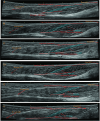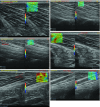A retrospective comparison of the biceps femoris long head muscle structure in athletes with and without hamstring strain injury history
- PMID: 38408057
- PMCID: PMC10896514
- DOI: 10.1371/journal.pone.0298146
A retrospective comparison of the biceps femoris long head muscle structure in athletes with and without hamstring strain injury history
Abstract
Introduction: Hamstring strain injuries (HSI) and re-injuries are endemic in high-speed running sports. The biceps femoris long head (BFlh) is the most frequently injured muscle among the hamstrings. Structural parameters of the hamstring muscle are stated to be susceptible to strain injuries at this location. This retrospective study targeted comparing the BFlh's structural parameters between previously injured and uninjured athletes.
Methods: Nineteen male athletes with previous BFlh strain injury history and nineteen athletes without former lower extremity injury history were included in this study. Fascicle length, mid-muscle belly and distal musculotendinous (MTJ) passive stiffnesses of the biceps femoris long head (BFlh) were examined via b-mode panoramic ultrasound scanning and ultrasound-based shear-wave elastography. Parameter comparisons of both legs within and between athletes with and without injury history were performed.
Results: Comparison of the BFlh fascicle length between the injured leg of the injured group and the legs of the controls revealed a trend to shorter fascicle lengths in the injured leg (p = 0.067, d = -0.62). However, the mid-muscle belly passive stiffness of the BFlh was significantly higher in the injured legs (p = 0.009, d = 0.7) compared with the controls. Additionally, the distal MTJ stiffness was much higher in the previously injured legs compared with controls (p < 0.001, d = 1.6).
Conclusions: Outcomes support the importance of BFlh properties related to stiffness, and fascicle length for injury susceptibility in athletes. Future prospective studies should determine whether the higher stiffness in the injured athletes is a cause or consequence of the HSI. Physical therapy and rehabilitation programmes after HSI should focus on BFlh muscle properties i.e., elasticity and fascicle length for reducing re-injury and increasing sports performance.
Copyright: © 2024 Yagiz et al. This is an open access article distributed under the terms of the Creative Commons Attribution License, which permits unrestricted use, distribution, and reproduction in any medium, provided the original author and source are credited.
Conflict of interest statement
The authors have declared that no competing interests exist.
Figures



Similar articles
-
Do athletes with hamstring strain injury have shorter muscle fascicles in the injured limb?J Bodyw Mov Ther. 2024 Apr;38:269-273. doi: 10.1016/j.jbmt.2024.01.030. Epub 2024 Jan 28. J Bodyw Mov Ther. 2024. PMID: 38763569
-
Smaller Biceps Femoris Aponeurosis Size in Legs with a History of Hamstring Strain Injury.Int J Sports Med. 2024 Dec;45(13):871-883. doi: 10.1055/a-2348-2605. Epub 2024 Jun 19. Int J Sports Med. 2024. PMID: 38897227
-
Biceps femoris long head muscle and aponeurosis geometry in males with and without a history of hamstring strain injury.Scand J Med Sci Sports. 2024 Apr;34(4):e14619. doi: 10.1111/sms.14619. Scand J Med Sci Sports. 2024. PMID: 38572910
-
Is there a potential relationship between prior hamstring strain injury and increased risk for future anterior cruciate ligament injury?Arch Phys Med Rehabil. 2014 Feb;95(2):401-5. doi: 10.1016/j.apmr.2013.07.028. Epub 2013 Oct 9. Arch Phys Med Rehabil. 2014. PMID: 24121082 Review.
-
Does Muscle-Tendon Unit Structure Predispose to Hamstring Strain Injury During Running? A Critical Review.Sports Med. 2021 Feb;51(2):215-224. doi: 10.1007/s40279-020-01385-7. Epub 2020 Dec 24. Sports Med. 2021. PMID: 33368028 Review.
Cited by
-
Hamstring Muscle Stiffness in Athletes with and without Anterior Cruciate Ligament Reconstruction History: A Retrospective Study.J Clin Med. 2024 Jul 26;13(15):4370. doi: 10.3390/jcm13154370. J Clin Med. 2024. PMID: 39124637 Free PMC article.
-
Exploring the Posterolateral Corner of the Knee Joint: A Detailed Review of Recent Literature.J Clin Med. 2025 Feb 25;14(5):1549. doi: 10.3390/jcm14051549. J Clin Med. 2025. PMID: 40095472 Free PMC article. Review.
-
Neuromechanical basis of region-specific differences and their implications for sport performance and injury prevention: a narrative review.Eur J Appl Physiol. 2025 Jul 25. doi: 10.1007/s00421-025-05889-w. Online ahead of print. Eur J Appl Physiol. 2025. PMID: 40711548 Review.
References
-
- Ekstrand J, Bengtsson H, Waldén M, Davison M, Khan KM, Hägglund M. Hamstring injury rates have increased during recent seasons and now constitute 24% of all injuries in men’s professional football: the UEFA Elite Club Injury Study from 2001/02 to 2021/22. British Journal of Sports Medicine. 2022:bjsports-2021-105407. doi: 10.1136/bjsports-2021-105407 - DOI - PMC - PubMed
-
- Liu H, Garrett WE, Moorman CT, Yu B. Injury rate, mechanism, and risk factors of hamstring strain injuries in sports: A review of the literature. Journal of Sport and Health Science. 2012;1(2):92–101. doi: 10.1016/j.jshs.2012.07.003 - DOI
MeSH terms
LinkOut - more resources
Full Text Sources
Medical

